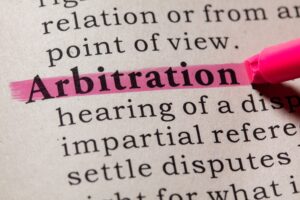
Arbitration as an Alternative in Family Law
Recently, we have had a number of cases where parties have good prospects to appeal, but a decision has been
Call us on
Part 2 – How Does The Law Determine What Is a Fair and Equitable Property Settlement?
This is part 2 of a 4 part series on understanding the basics of family law property settlement. You can read part 1 here.

In this part, I look at the four basic steps involved in ascertaining, according to law, what is a fair and equitable property settlement. The four steps to a property settlement can be summarised as follows:
Step 1 – Identifying and Valuing All Assets, Liabilities and Financial Resources
Essentially, under this first step, one must compile a current day spread sheet which identifies all assets, liabilities and financial resources that each party has at that day. This includes but is not limited to things such as: real estate, bank accounts, investments, cash savings, furniture and chattels, motor vehicles, companies, trusts, partnerships, superannuation interests and all other interests in property that a spouse may have at the current date.
The interest in property needs to be specifically identified and the value of that property needs to either be agreed between the parties or if no agreement can be reached, a valuation can be obtained from an expert. The law requires each separating party to make a full and detailed disclosure to the other party of all their financial interests at the current date. This step can often be a simple step, where the parties have few assets and can agree on what they are, or it can be a very complex step where there are substantial property interests that need to be identified and valued. Ultimately, one has to arrive at a completed matrimonial balance sheet, disclosing and identifying all assets, liabilities and resources with a value.
Step 2 – Assessing, Identifying and Evaluating Contributions
The second step in a property settlement is to look back in time and ascertain what contributions each party made to the acquisition, conservation and improvement of property. There is a common misconception that financial contributions are more important than other contributions. That is certainly not the case. Just because one party worked throughout the marriage and built up a business and paid off the mortgage, doesn’t mean that they will get back what they put in, nor does it mean that their contributions will be treated more valuable than the other parties contributions.
In this step, the law says that many contributions must be looked at and assessed. These contributions can be direct and indirect contributions. They can also be financial and non-financial contributions. Homemaking, parenting and domestic contributions are also included. There is literally a shopping trolley full of different types of contributions that need to be identified by a skilled family lawyer and assessed.
There are no hard and fast rules about how contributions are taken into account. The law allows a wide discretion in determining how those contributions should affect division of assets identified in Step 1.
Essentially, the following types of contributions are some of the more important ones that need to be identified and assessed:-
There is no presumption of 50/50 when assessing contributions. Each case is different and in each matter all of the relevant contributions must be identified, looked at and assessed.
The end result of Step 2 is that a conclusion is reached (generally expressed in percentage terms) as to the how the assets identified and valued in Step 1 are to be split.
For example, it may be that in a particular case the assets in Step 1 are valued at $1,000,000.00. The assessment of contributions may result in an assessment of 60% to the Wife and 40% to the Husband (as an example).
Step 3 – Assessing Current and Future Circumstances
The final substantial step in working out a fair property settlement is to look at the current and future circumstances that impact upon each party.
In Step 2, one looked back in time to look at contributions made by each party from the commencement of the relationship/marriage up to the current date.
In Step 3, current circumstances are assessed but the emphasis is looking forward to the future and how each party has come out of the relationship.
Under this step, the law says that various factors need to be identified and then evaluated. These factors include things such as:-
There are numerous other factors that need to be considered but the above are the main factors. Under this step, the law once again provides a wide discretion as to what can be said to be fair and equitable, having regard to the financial circumstances of each case.
Typically, for example, one party may receive a greater share of the property under this third step because they do not have an income earning capacity and spent the entire marriage caring for and raising the children. Therefore, in a matter such as that the outcome may be that that party receives a further amount of property than what was determined under Step 2.
There is no hard and fast rule about percentage adjustments that are made under Step 3. Typically, one has to look at the size of the proposed cash adjustment to see whether that is fair in the circumstances of the particular case. Typically that cash adjustment has been expressed again as a further percentage adjustment.
Therefore, under this third step, a further percentage adjustment may be made in favour of a party in addition to any percentage adjustment made in Step 2.
In Steps 1 and 2 above, in our example, we decided the assets were worth $1,000,000.00 and that the Wife would receive 60% of those assets and the Husband 40% because of contributions. Under this third step, let’s assume that a further adjustment would be made in favour of the Wife of 10%.
Therefore, after the above three steps are completed the Wife would receive 70% and the Husband 30% of the assets. Once again, this is an example and not indicative of any typical outcome.
Step 4 – Just and Equitable Requirement
A final step in the above process is effectively a ‘checking’ step to make sure that the Order is in all circumstances fair and equitable.
This step is really an automatic step and rarely alters the percentage divisions we arrived at in Steps 2 and 3.
However, this fourth step can sometimes be important in determining whether a party keeps an asset (such as a matrimonial home for the party to reside in with the children or whether one party retains a business in front of another party). In other words, this is a final step where the law has to check an Order it proposes to make in relation to property settlement to ensure that in all circumstances it is a just and equitable Order between the parties.
The above is a brief summary of the four step process that applies in a property settlement. In Part 3, I will explain the different ways in which property settlements can be negotiated and resolved.
In this part, I look at the four basic steps involved in ascertaining, according to law, what is a fair and equitable property settlement. The four steps to a property settlement can be summarised as follows:

Recently, we have had a number of cases where parties have good prospects to appeal, but a decision has been

Recently, we have had a number of cases where parties have good prospects to appeal, but a decision has been

Recently, we have had a number of cases where parties have good prospects to appeal, but a decision has been

© 2024 Hartley Family Law – All Rights Reserved | Privacy | Terms & Conditions

The Privacy Statement of the Company is incorporated into these Terms and Conditions. The Company respects the privacy of all its customers and business contacts. The Company is subject to the requirements of the National Privacy Principles which are contained in the Privacy Act.
1. How is personal information collected?
Your name, email address and phone number are collected on the contact form to allow the Company to contact you.
If you email or phone the Company directly, then the Company may record your personal details.
Your personal information may be used to:
a) Improve service to you, the customer
b) The Company may use personal information about you for marketing and research purposes. If you do not wish this to occur, please contact us and we will ensure this does not occur
c) Your personal information is not disclosed to any organisation outside of the Company.
2. Will personal information be given to anyone else?
The Company does not sell or provide your personal information to any other company.
3. Security of personal information
The Company employees are required, as a condition of their employment, to treat personal information held by the Company as confidential, and to maintain the confidentiality of that personal information.
The Company protects the personal information it collects in a secure database.
4. Access and correction
You can access your data at any time by contacting the Company directly.
You also have the right to ask us to correct information about you which is inaccurate, incomplete or out of date.
We ask you to contact the Company by email or phone using the Company contact details if you wish to access or correct any of your personal details.
5. Online privacy issues
To the extent that this Privacy Policy applies to online privacy issues, it is to be read as forming part of the terms of use for our website. When you deal with the Company whether online or otherwise, the Company takes its privacy obligations seriously.
6. Additional privacy information and how to contact the Company
The Company may change its Privacy Policy at any time.
For further information about privacy issues and the protection of privacy visit the Australian Federal Privacy Commissioner’s website at www.privacy.gov.au. If you feel that The Company is not complying with this Privacy Policy, or if you have other privacy concerns, please contact the company.